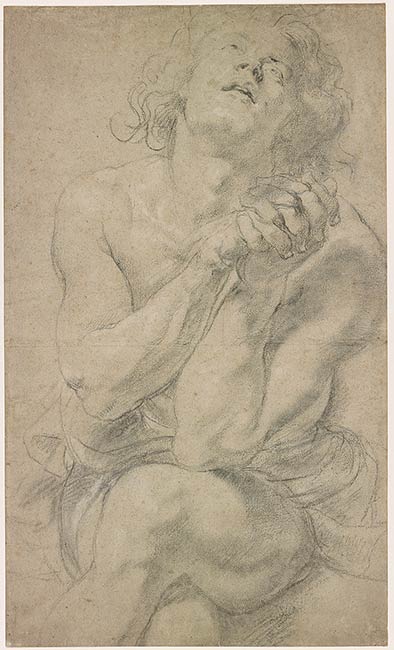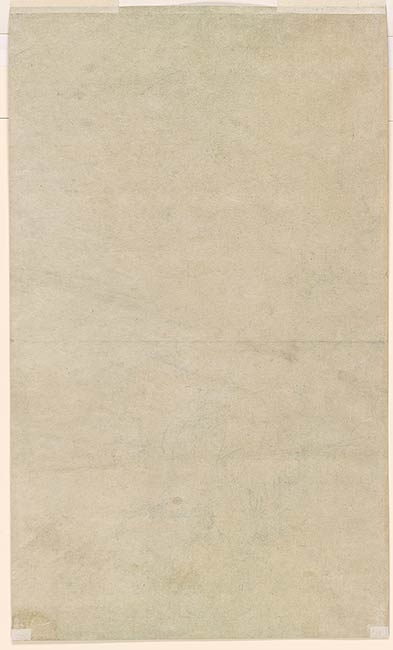

Peter Paul Rubens remains among the most innovative painters in Western art, his dramatic depictions of biblical events or hunting scenes still an inspiration for modern-day masterworks, like Kehinde Wiley's exquisite, life-sized portraits. Ruben's drawings are also superlative expressions of his skill, for though the artist's paintings are often done on larger-than-life scale (many measuring meters in length), the intimate medium of drawing often reveals the genesis of his inimitable painterly prowess. Such is the case with the present artwork: a tour de force, this powerful drawing of a muscular male nude is a study for the Old Testament biblical figure of Daniel in Ruben's celebrated painting Daniel in the Lion's Den (National Gallery of Art, Washington, D.C.). The artist's nearly unparalleled ability to draw the human form with breathtaking naturalism and verve is here exemplified; using a delicate but firm line, alongside subtle shading, Rubens conjures a striking vision of a desperate man who, according to the bible, was ordered to spend the night in a den of hungry lions. Daniel's wildly messy hair and intertwined legs, fingers, and arms make him appear (impossibly) as if he has twisted himself into a knot. His tilting head, open mouth, and distant, glassy-eyed gaze can but further attest to his distress and fatigue. He seems to plead with someone or something we cannot see. Indeed, the bible recounts that Daniel's faith in god ultimately saves him from a gory fate. Rubens's drawing does not show us the lions, but rather achieves a more wondrous feat: Daniel's contorted musculature makes visible his inner strength, before us his trembling body transformed by God's enigmatic omnipotence.
Rubens likely drew this formidable figure from a live model, a practice he frequently employed and one that he would teach to his pupils, including the talented Anthony van Dyck and Jacob Jordaens. Rubens famously listed this painting in a letter of April 1618 to Sir Dudley Carelton, the English ambassador in The Hague, as “Daniel among many lions, taken from life.” The minimal differences between the figure in the drawing and in the painting suggest that Rubens executed the drawing during the final phases of preparing the painting, probably around 1613. Scholars have also pointed that Rubens's Daniel may have also been inspired by a drawing by Italian artist Girolamo Muziano, which Rubens probably owned, and a famous Hellenistic marble bust, the so-called Dying Alexander (now Galleria degli Uffizi, Florence). It seems likely that Rubens instructed his young model to pose in exactly the same position as Muziano's St. Jerome, and to adopt an expression similar to the Hellenistic prototype. This drawing therefore provides a strong example of Rubens's philosophy, as he expressed in his unpublished treatise 'De imitatione statuarum,' of ca. 1608, that good art should always respond to old art, but ultimately always imitate nature. Indeed, Rubens's spirited rendering of his model's broad cheekbones, full lips and muscular body yields a fresh, highly original drawing.
Text from Ilona van Tuinen with contributions by Sarah W. Mallory.
Watermark: dolphin.
Numbered on verso, in graphite, "2".
Bates, William, -1884, former owner.
Robinson, J. C. (John Charles), Sir, 1824-1913, former owner.
Murray, Charles Fairfax, 1849-1919, former owner.
Morgan, J. Pierpont (John Pierpont), 1837-1913, former owner.
Tuinen, Ilona van. Power and Grace : Drawings by Rubens, Van Dyck, and Jordaens. New York : Morgan Library & Museum, 2018, no. 4 (repr.)
Collection J. Pierpont Morgan : Drawings by the Old Masters Formed by C. Fairfax Murray. London : Privately printed, 1905-1912, I, 232.
Stampfle, Felice, with the assistance of Ruth S. Kraemer and Jane Shoaf Turner. Netherlandish Drawings of the Fifteenth and Sixteenth Centuries and Flemish Drawings of the Seventeenth and Eighteenth Centuries in the Pierpont Morgan Library. New York : Pierpont Morgan Library, 1991, p. 142, no. 306, repr.
From Leonardo to Pollock: Master drawings from the Morgan Library. New York: Morgan Library, 2006, cat. no. 37, p. 80-81.
